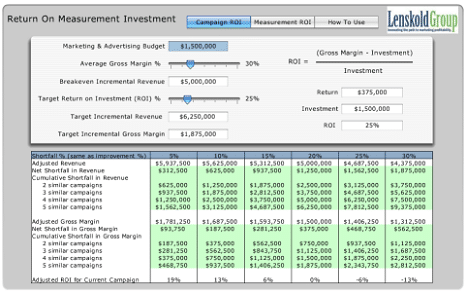
In this guest blog, marketing ROI guru Jim Lenskold, a speaker at one of i-SCOOP’s events, looks at a handful of key principles you should know to improve your digital marketing ROI.
Fundamentally, marketing ROI is a process of continuously improving marketing performance and profitability by applying deeper insights to maximize the effectiveness of strategic and tactical decisions. Those insights are generated from carefully designed measurements and financial assessments of ROI to ensure that the marketing contribution of profits exceeds the marketing investment while meeting appropriate short- and long-term objectives.
Digital marketing strategy benefits from marketing ROI measurements into digital marketing influence on buyer’s path to purchase and the incremental contribution of digital marketing tactics within the overall marketing mix.
Key measurements to improve digital marketing
- Capturing incremental sales conversions and customer value to optimize the digital marketing spend. Digital marketing has the advantage of tracking actions and behaviors but not always to the point of a sales conversion and customer value.
- Testing of targeting, offers, frequency, and messaging that not only improve online marketing performance but can also be implemented in broader media channels.
- Using modeling to understand how offline media drives online behaviors and conversion rates.
- Using modeling to assess the contribution of online marketing to offline sales, especially for digital content used in the “research” phase of the buying cycle prior to major offline purchases.
- Using modeling to detect the interaction effects, cross-over impact, and synergies between marketing tactics.
In addition to measurements, ROI analysis is used to prioritize digital marketing initiatives that have greater impact on high value segments and driving conversions, identify where incremental spend can generate positive returns, provide guidance on the point of diminishing returns, and indicate where improvements in supporting the buyer’s purchase funnel can have the greatest impact.
What’s the ROI on marketing ROI measurement?
Investments into marketing ROI decision support tools, measurements, analytics, and processes are all fortunately designed to generate incremental profits from increased sales and customer value. Marketing organizations should increase their investment in ROI measurements if: 1) they can benefit from insight into effect (or have unknowns) and; 2) they are ready to act on insights. If ROI measurement is strictly for reporting purposes, the investment may get questioned.
It is not possible to measure everything in marketing so measurements must be prioritized based on the expected improvement to effectiveness, the strategic benefit of gaining insights that can influence many marketing initiatives, and the cost. This discipline of measurement prioritization will concentrate limited budgets on measurements likely to have greater impact. To help justify your measurement investment, use our Return on Measurement Investment Tool.
Acting on insight

There is no question that the most important step in measuring marketing ROI is to demonstrate that you can act on insights to improve ROI. The marketing organization builds credibility by running ROI scenarios and conducting measurements that show positive ROI on current marketing initiatives; a good first step.
However, marketing builds confidence within an organization when strategies or tactics are changed to grow sales and profits. It is especially important to approach ROI with the expectation of improving results since there will be some marketing initiatives that show negative or low ROI performance levels when first measured. Measurements should provide insight to improve those initiatives instead of just eliminating them in favor of new, unproven initiatives.
The process of improving an organization’s marketing ROI begins during the measurement planning stage. Make sure your measurements are designed: 1) with a clear plan for how the results will be implemented and; 2) to influence decisions with high profit potential, as determined by running basic ROI scenarios.
Continuous Improvement
Measurements of marketing initiatives show ROI results ranging from very negative to levels in excess of 1000%. While it is important to generate positive ROI levels above a required threshold, it is even more important to constantly support the process of measuring and improving ROI. This discipline of constantly improving effectiveness builds confidence and credibility that marketing can deliver results for the organization.
Here are five key principles for improving the returns on your marketing.
- Run ROI Scenarios
Whether you are using a very basic calculator or a sophisticated scenario planning tool, running ROI scenarios in the planning stage to quantify your expected outcomes will guide your decisions to improve the profit potential. It is also beneficial for building a case for different strategies or spending levels. - Prioritize Measurements
Generate measurements and analytics that provide insight into financial outcomes. A good measurement plan includes a mix of basic tracking and more advanced measures. If you are seeking to expand your measurement or ROI analytics, make sure to include high impact measurements that are actionable to win support for additional measurement funding. - Make Marketing More Measurable
When measurements are planned concurrently with marketing plans, small modifications to the implementation can have significant benefits for measurements. This includes setting up control groups, varying the marketing mix or spending levels in select areas, completing benchmark research, or introducing more variance in media channels to improve modeling precision. - Assess Incremental Conversions & Value
Many touch points are working together to generate sales so the measurement of any specific marketing initiative should assess its incremental contribution. Market testing, analytics, and modeling can be used to isolate a tactic’s contribution within the overall marketing mix. Marketing initiatives that contribute to progression in the buyer’s funnel must be linked to sales conversions. Sales conversions should account for total incremental customer value, including repeat purchase, retention and growth from higher value segments. It can take time and effort to establish the measurements necessary to fully address the contribution of marketing but each step in the process provides valuable insight. - Experiment Frequently
Measuring marketing effectiveness and acting on that information in the next cycle of marketing will lead to improvements in ROI. Improvements in ROI are accelerated when the measurements are designed to not only provide insight on your current marketing initiatives, but also on alternatives that are run concurrently. This can include alternative executions such as variations in the marketing mix, analyzing performance of different target segments, introducing new tactics, or testing new offers. With a small portion of the total budget for experimentation, new insights can generate leaps in performance.

